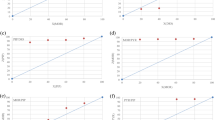Abstract
Here we investigate and compare the more salient characteristics of host–guest complexes of (+)-(2R,3R)-1,1-4,4-tetraphenylbutane-1,2,3,4-tetraol (TETROL) with four heterocyclic guests, morpholine, piperidine, pyridine and dioxane. These guests each formed inclusion compounds with TETROL, and host:guest ratios were either 1:2 or 1:1. Single crystal diffraction experiments revealed unprecedented host behaviour in the presence of both piperidine and dioxane with respect to the mode of host–guest hydrogen bonding employed. Furthermore, by utilizing 1H-NMR spectroscopy or gas chromatography (as applicable) as methods for analysing complexes obtained from competition experiments, we were able to identify the host selectivity order, and were gratified to discover that this order correlated precisely with host–guest hydrogen bond distance.





Similar content being viewed by others
References
Lehn, J.-M., Sanders, J.: Book review: chemistry beyond the molecule: supramolecular chemistry. Concepts and perspectives. Angew. Chem. Int. Ed. Engl. 34(22), 2563–2563 (1995)
Steed, J.W., Atwood, J.L.: Supramolecular chemistry. Hoboken, Wiley. (2009)
Atwood, J.L., Steed, J.W.: Encyclopedia of supramolecular chemistry. CRC Press, New York (2004)
Fischer, E.: The influence of configuration on enzyme activity. Dtsch Chem. Ges. 27, 2984–2993 (1894) (translated from German)
Cheng, Y., Wang, J., Rao, T., He, X., Xu, T.: Pharmaceutical applications of dendrimers: promising nanocarriers for drug delivery. Front. Biosci. 13, 1447–1471 (2008)
Iskierko, Z., Noworyta, K., Sharma, P.S.: Molecular recognition by synthetic receptors: application in field-effect transistor based chemosensing. Biosensors Bioelectron. 109, 50–62 (2018)
Jenatsch, S., Wang, L., Leclaire, N., Hack, E., Steim, R., Anantharaman, S.B., Heier, J., Ruhstaller, B., Penninck, L., Nüesch, F., Hany, R.: Visible light-emitting host-guest electrochemical cells using cyanine dyes. Org. Electron. 48, 77–84 (2017)
Yu, H.R., Hu, J.-Q., Liu, Z., Ju, X.-J., Xie, R., Wang, W., Chu, L.-Y.: Ion-recognizable hydrogels for efficient removal of cesium ions from aqueous environment. J. Hazard. Mater. 323, 632–640 (2017)
Seebach, D., Beck, A.K., Heckel, A.: TADDOLs, their derivatives, and TADDOL analogues: versatile chiral auxiliaries. Angew. Chem. Int. Ed. 40, 92–138 (2001)
Barton, B., Caira, M.R., Hosten, E.C., McCleland, C.W.: A computational, X-ray crystallographic, and thermal stability analysis of TETROL and its pyridine and methylpyridine inclusion complexes. Tetrahedron 69, 8713–8723 (2013)
Barton, B., Caira, M.R., Hosten, E.C., McCleland, C.W., Weitz, S.: Clathrates of TETROL: selective inclusion of methylcyclohexanones in their energetically unfavorable axial methyl conformations. Chem. Commun. 50, 13353–13355 (2014)
Barton, B., Caira, M.R., Hosten, E.C., McCleland, C.W., Weitz, S.: Clathrates of TETROL: further aspects of the selective inclusion of methylcyclohexanones in their energetically unfavorable axial methyl conformations. J. Org. Chem. 80, 7184–7192 (2015)
Barton, B., Dorfling, S.-L., Hosten, E.C.: Cyclohexanone-driven discriminatory behaviour change of host compound (+)-(2R,3R)-TETROL for the isomeric methylcyclohexanone guests. Cryst. Growth Des. 17, 6725–6732: (2017)
Barton, B., Dorfling, S.-L., Hosten, E.C.: Hydrogen bonding, the driving force for increased host selectivities in two-solvent mixed complexes of TETROL comprising both favoured (aniline) and disfavoured guests (o-toluidine or toluene). Cryst. Growth Des. 18, 3569–3575 (2018)
Barton, B., Dorfling, S.-L., Hosten, E.C., Pohl, P.L.: Host compounds (+)-(2R,3R)-1,1,4,4-tetraphenylbutane-1,2,3,4-tetraol (TETROL) and (2R,3R)-(−)-2,3-dimethoxy-1,1,4,4-tetraphenylbutane-1,4-diol (DMT) with guests o-, m- and p-toluidine: a comparative investigation. Tetrahedron 74, 2754–2761 (2018)
Shan, Z., Hu, X., Zhou, Y., Peng, X., Li, Z.: A convenient approach to C 2-chiral 1,1,4,4-tetrasubstituted butanetetraols: direct alkylation or arylation of enantiomerically pure diethyl tartrates. Helv. Chim. Acta 93(3), 497–503 (2010)
APEX2, SADABS, S.A.I.N.T; Bruker, A.X.S.: Madison, Wisconsin, USA (2010)
Sheldrick, G.M.: SHELXT–Integrated space-group and crystal structure determination. Acta Crystallogr. A 71(1), 3–8 (2015)
Hübschle, C.B., Sheldrick, G.M., Dittrich, B.: ShelXle: a Qt graphical user interface for SHELXL. J. Appl. Crystallogr. 44(6), 1281–1284 (2011)
Barton, B., de Jager, L., Dorfling, S.-L., Hosten, E.C., Pohl, P.L.: Host behaviour of related compounds, TETROL and DMT, in the presence of two different classes of aromatic guest compounds. Tetrahedron 74, 4754–4760 (2018)
Bondi, A.: van der Waals volumes and radii. J. Phys. Chem. A 68(3), 441–451 (1964)
Barabash, R.I., Ice, G.E., Turchi, P.E.A.: Diffuse scattering and the fundamental properties of materials, Momentum Press: New York (2009)
Mooibroek, T.J.: Coordinated nitrate anions can be directional π-hole donors in the solid state: a CSD study. CrystEngComm. 19(31), 4485–4488 (2017)
Abraham, M.H., Duce, P.P., Prior, D.V., Barratt, D.G., Morris, J.J., Taylor, P.J.: Hydrogen bonding. Part 9. Solute proton donor and proton acceptor scales for use in drug design. J. Chem. Soc., Perkin Trans 2(10), 1355–1375 (1989)
Dance, I.: Distance criteria for crystal packing analysis of supramolecular motifs. New J. Chem. 27, 22–27 (2003)
Acknowledgements
Financial support is acknowledged from the Nelson Mandela University and the National Research Foundation. Prof. Mino Caira (University of Cape Town) is thanked for fruitful hydrogen bond discussions.
Author information
Authors and Affiliations
Corresponding author
Electronic supplementary material
Below is the link to the electronic supplementary material.
Rights and permissions
About this article
Cite this article
Barton, B., Dorfling, SL. & Hosten, E.C. Complexes of TETROL with selected heterocyclics: unconventional host–guest hydrogen bonding and the correlation with host selectivity. J Incl Phenom Macrocycl Chem 92, 251–259 (2018). https://doi.org/10.1007/s10847-018-0840-y
Received:
Accepted:
Published:
Issue Date:
DOI: https://doi.org/10.1007/s10847-018-0840-y




